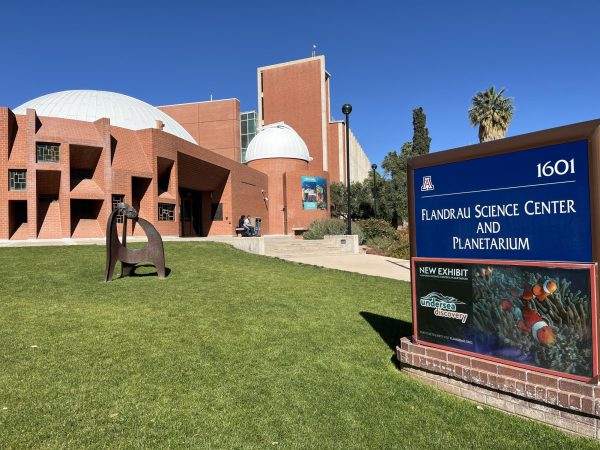Climate change has been a topic of discourse since the beginning of most college students education. These conversations typically lead with phrases like we need to save our planet and often conclude with the shared understanding that consuming fossil fuels and producing greenhouse gasses at the current rate will lead to irreversible consequences.
The truth is climate change is marketed towards saving the planet, but rhetoric should also highlight the harsh effects it will have on basic human needs.
Climate change refers to “long-term shifts in temperatures and weather patterns,” according to the United Nations. Although these changes can occur naturally, the process is accelerating at an exponential rate due to human activity.
Just in the past year, the U.S. reached a new record of natural disasters that cost over $57.6 billion and resulted in more than 253 deaths, according to the National Oceanic and Atmospheric Administration. Some of these disasters include the wildfires in Hawaii, Hurricane Idalia crashing into Florida and severe hailstorms in Minnesota to name a few. Along with this, heat waves, water scarcity and rising sea levels pose a threat to the future of global humanity.
The National Centers for Environmental Information reported that June-August in 2023 was the hottest summer on record across the globe. This trend has been seen throughout America, with Phoenix having an average temperature of 102.8 degrees Fahrenheit for July, Death Valley soaring to 128 degrees Fahrenheit on July 16 and Chicago experiencing 100 degrees with a 120-degree heat index since 2016. The list continues internationally, as the average global temperature has increased by 1.9 degrees Fahrenheit since 1880, according to Earth Observatory.
According to the Environmental Protection Agency, prolonged exposure to high temperatures causes various medical concerns, like exhaustion, heat strokes and kidney and heart diseases.
Research studies like the 40-year forecast of cardiovascular deaths due to increased temperature conducted by Assistant Professor of Medicine at the Perelman School of Medicine Dr. Sameed Khatana, estimated that the amount of heat-related cardiovascular deaths in the U.S. would rise by up to 233% from 2036 to 2065.
Older adults and non-Hispanic Black individuals in the U.S. will face the brunt of cardiovascular deaths due to extreme heat conditions. According to a study from the University of Pennsylvania conducted in 2018, “Black Americans were 30% more likely to die from heart disease than white Americans” and develop heart disease at a younger age due to historic under-investment in marginalized communities. This stems from lack of accessibility of preventative care, poor infrastructure and absence of grocery stores resulting in the shortfall of healthy options, forming food deserts.
As reported by Forbes, “according to the American Public Health Association, communities of color are more likely to experience pre-existing health conditions and poor living conditions than their white counterparts.”
The underlying diagnosis of these various adverse health effects is that climate change will disproportionately affect minorities over others.
While the U.S. is more diverse than ever, cities remain segregated and low-income neighborhoods are disadvantaged by the darker materials used for road construction (which trap excessive heat), the lack of soil and grass within the community (which naturally aids in decreasing the surrounding temperatures) and have less access to air conditioning.
For example, in southern Los Angeles, where communities are predominantly people of color, according to Forbes “nearly three-fifths of households did not have access to air conditioning in 2020.”
Low-lying areas, which are predominantly low-income and communities of color, are at increased risk of catastrophic flooding caused by hurricanes. A study by the Joint Center for Political and Economic Studies found “more than 30% of Black New Orleans residents didn’t own cars when Hurricane Katrina hit in 2005,” complicating leaving the area ahead of the storm.
Without financial resources to access commodities like air conditioning and cars, communities of color are susceptible to the first-line dangers of climate change with little assistance.
Though individuals are constantly encouraged to make lifestyle changes such as carpooling, conserving energy at home, using public transportation and opting for reusable products, the question arises about the fairness of placing the entire responsibility of climate change on individuals alone. While personal changes in lifestyle do add up, corporations and conglomerates should also be held accountable for their contributions to increasing fossil fuel consumption and the current state of the planet.
The Inflation Reduction Act of 2022, passed by the Biden Administration, is a tax incentive for Americans who purchase electric vehicles and create a more sustainable home. The bill aims to provide incentives to accelerate the transition to an energy-efficient and sustainable system that remains financially responsible for reducing carbon emissions.
Kirsten Engel, professor of law at the James E. Rogers College of Law and previous member of the Arizona House of Representatives and Arizona Senate, said that the IRA has “been the biggest investment into the transition to clean energy that has occurred.”
“Money is coming into the state to support clean energy facilities and is predicted to see $10 billion of investment between public funding and private investment,” Engel said.
In addition to the tax incentives it provides, the IRA invests in clean energy and infrastructures. It provides funding for a wide range of programs that range from renewable energy projects, to electric vehicle infrastructure, to enhancing public transportation, intending to create jobs and reduce carbon emissions, according to the US Department of the Treasury.
According to Engel, this should not be a politicized issue, despite a Republican push to repeal clean energy investments.
“Our main focus is to make sure that the law is not repealed, as there was a push by the Republican majority in congress to repeal the clean energy investments and this should not be a politicized issue as we all want to reduce the negative impacts,” Engel said.
The University of Arizona is “currently undergoing its first-ever sustainability and climate action planning process, so we are putting together a roadmap to how we will reach planet neutrality by 2040,” said Trevor Ledbetter, director of the Office of Sustainability at the University of Arizona.
A subpart of this plan focuses on the decarbonization of the UA campus through a variety of initiatives that “specifically assess ways to improve the energy efficiency of our buildings, how we ship vehicles and other sorts of equipment and most importantly modernizing our old infrastructure,” according to Ledbetter.
The UA currently acquires its electricity from Tucson Electric Power through renewable resources, but the remaining 40% of electricity is produced by the co-generational natural gas turbines located on campus, which are not as sustainable or efficient. So, part of the decarbonization plan is to remove the co-generational natural gas turbines, take them offline, modernize the systems the university uses and electrify them, according to Ledbetter.
UAZ Divest is a student group that has pushed for the UA Foundation to divest from fossil fuels and phase out the current investments, “so through 2029, as those investments mature, UA will not renew them,” Ledbetter said.
While the UA is making strides in these areas, there are no federal legislation or measures to reduce greenhouse gasses specifically produced by the corporations across the nation.
According to an analysis by the University of Chicago, for every dollar U.S. conglomerates and corporations make in profit, greenhouse gas emissions cause 18.5 cents worth of damage.
To hold these corporations accountable and to increase transparency with the public, the Securities and Exchange Commission proposed to make public companies disclose the amount of greenhouse gas emissions generated Spring of 2022 which has come into fruition this 2024, according to the New York Times.
The SEC in 2022, ordered companies to share the pollutants generated by its business into different components. Scope one and two would report both direct and indirect greenhouse gas emissions from waste produced in manufacturing to the amount of air condition used in the office building and scope three refers to the emissions created as a result of the product it creates, according to CNN. SEC’s proposed rule continues to be debated in 2024 as “ten Republican-led states filed a petition to block the Securities and Exchange Commission’s climate-risk disclosure rule shortly after it was finalized” on March 6 which later led to the third scope being eliminated in the approved plan.
According to the Pew Research Center, climate change being considered as a top priority has increased from 38% to 52% among Americans and, with the public urges for legislative changes, will this collective effort translate into legislation holding corporations accountable and propelling in the direction of sustainable energy?
It is a major election year and this can allow for Americans as a collective to take deliberate action by voting with regard to this issue.
Follow the Daily Wildcat on Instagram and Twitter/X











